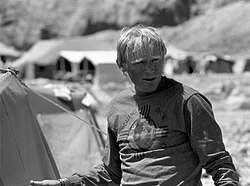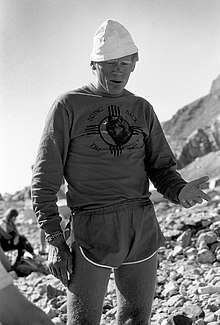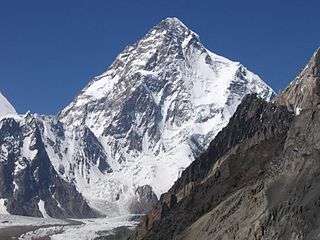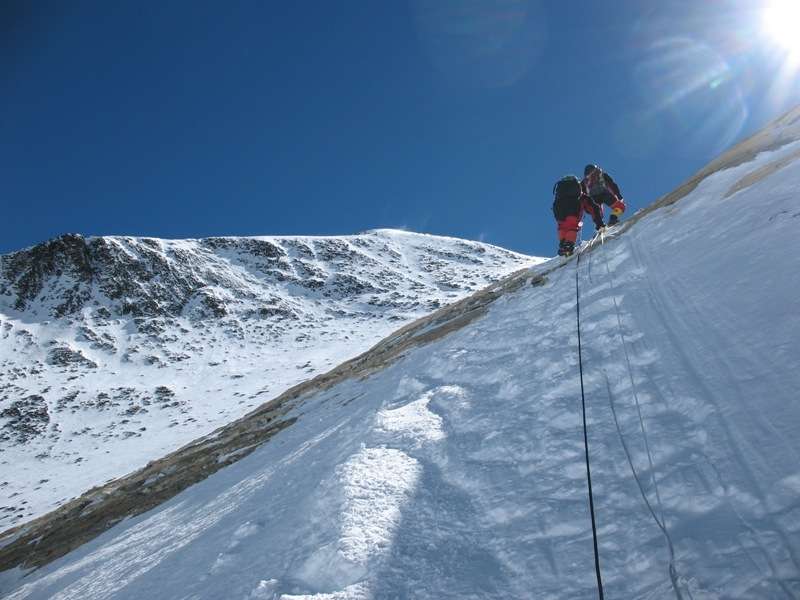Anatoli Boukreev
Anatoli Nikolaevich Boukreev (Russian: Анато́лий Никола́евич Букре́ев; January 16, 1958 – December 25, 1997) was a Russian Kazakhstani mountaineer who made ascents of 10 of the 14 eight-thousander peaks—those above 8,000 m (26,247 ft)—without supplemental oxygen. From 1989 through 1997, he made 18 successful ascents of peaks above 8000 m.
Anatoli Boukreev | |
|---|---|
 In 1991 | |
| Born | Anatoli Nikolaevich Boukreev January 16, 1958 |
| Died | December 25, 1997 (aged 39) |
| Cause of death | Avalanche |
| Citizenship | Kazakhstan |
| Education | Bachelor of Science |
| Alma mater | Chelyabinsk State University |
| Occupation | Mountaineer |
| Known for | 18 ascents of 8000m peaks, 1996 Mount Everest disaster rescues |
| Awards | David A. Sowles Memorial Award |
Boukreev had a reputation as an elite mountaineer in international climbing circles for summiting K2 in 1993 and Mount Everest via the North Ridge route in 1995, and for his solo speed ascents of some of the world's highest mountains. He became even more widely known for saving the lives of climbers during the 1996 Mount Everest disaster.
In 1997, Boukreev was killed in an avalanche during a winter ascent of Annapurna in Nepal.[1] Boukreev's companion, Linda Wylie, edited his memoirs and published them in 2002 under the title, Above the Clouds: The Diaries of a High-Altitude Mountaineer.
Biography
Boukreev was born in Korkino, within the Soviet Union's Russian SFSR. He came from the narod, the common people, and his parents were both poor.[2] After completing high school in 1975, he attended Chelyabinsk University for Pedagogy, where he majored in physics and earned his Bachelor of Science degree in 1979. At the same time, he also completed a coaching program for cross-country skiing.
After graduation, the 21-year-old dreamed of mountain climbing. Boukreev moved to Alma-Ata, the capital of the neighbouring Kazakh SSR (present day Kazakhstan) located in the Tian Shan mountain range. From 1985 he was part of a Kazakhstani mountaineering team, and he became a citizen of Kazakhstan in 1991 after the breakup of the Soviet Union.
Boukreev worked as a commercial guide in the 1990s, and was working with Scott Fischer's adventure company Mountain Madness during the 1996 Mount Everest disaster.[3] He managed to survive and was also instrumental in saving the lives of others, including New York socialite Sandy Hill Pittman.[4]
Climbing accomplishments

Highlights
1987
- Lenin Peak (7,134 m) – First solo ascent
1989
- April 15 Kangchenjunga (8,586 m) – new route with Second Soviet Himalaya Expedition
- April 30 - May 2 Kangchenjunga – first traverse of the four 8,000 m summits of the massif
1990
1991
- May 10 Dhaulagiri – new route on the west wall with First Kazakhstan Himalaya Expedition
- October 7 Mount Everest – South Col route
1993
1994
- April 29 Makalu II (8,460 m)
- May 15 Makalu (8,476 m)
1995
- May 17 Mount Everest – North Ridge route
- June 30 Peak Abai (4,010 m) – guide for President of Kazakhstan
- October 8 Dhaulagiri (8,176 m) – fastest ascent record (17h 15m)
- December 8 Manaslu (8,156 m) – with Second Kazakhstan Himalaya Expedition
1996
- May 10 Mount Everest – South Col route
- May 17 Lhotse – solo ascent, speed record at 21 h 16 min from Base Camp to summit without supplemental oxygen.
- September 25 Cho Oyu (8,201 m) with Third Kazakhstan Himalaya Expedition
- October 9 North summit of Shishapangma (8,008 m)
1997
- April 24 Mount Everest (8,848 m) South Col Route as guide for Indonesian military expedition
- May 23 Lhotse (8,516 m)
- July 7 Broad Peak (8,047 m) – solo ascent
- July 14 Gasherbrum II (8,035 m) – solo ascent
Denali
In May 1990, Boukreev was invited by an American climber to guide several clients to the summit of Denali in Alaska. Denali, previously known as Mount McKinley, has challenges such as hidden crevasses and unpredictably cold weather due to its proximity to the Arctic Circle and the ocean.
The expedition was a success and the team reached the summit and returned without incident. During the climb there had been somewhat of a language barrier and Boukreev felt the sting of needing to borrow equipment due to his economic circumstances. After the team had returned home, Boukreev decided to attempt a solo speed ascent of Denali before returning to the Soviet Union.[5]
Boukreev's solo speed ascent of Denali in 1990 was completed in 10½ hours from the base to the summit.[6] That season acclimated climbers were normally taking three to four days and five camps to summit — Boukreev's feat was noted by Climbing magazine in a 1990 issue, and commented on by Denali Park rangers who described it as "unreal".[6]
K2
In 1993, Boukreev reached the summit of K2 via the Abruzzi Spur, where he shared the peak with team members Peter Metzger of Germany and Andy Locke of Australia. The other team members were German climbers Reinmar Joswig (the team leader) and Ernst Eberhardt. With a peak elevation of 8,611 metres (28,251 ft), K2 is the second-highest mountain on Earth after Mount Everest.
As part of the Karakoram range, K2 is located on the border between Pakistan and China. K2 is referred to as the "Savage Mountain" — notable for its steep pyramidal relief, dropping quickly in almost all directions, and the inherent danger in climbing it.[7] The danger facing Boukreev on K2 was that the summit felt like the finish line. Boukreev would later write that he did not feel the emotions of victory in that moment on top of K2's peak because he was physically and emotionally spent. Boukreev found himself in a dangerous position. He had expended too much energy placing fixed lines along a narrow, steep portion earlier that day. But since the team wanted to push on to the summit that same afternoon, rather than return to their tents to sleep and make a summit bid the next morning, Boukreev acquiesced.[8] Boukreev would later write:
During my years of training as a ski racer, and then as a mountaineer, I had learned how to wring out the last of my energy for a finish. But this is dangerous in mountaineering, because the summit is not the finish of your competition with a great mountain. To survive you must be able to get down from the forbidden zone.[9]
Boukreev later described feeling like a "squeezed lemon".[9] When Boukreev and the other two climbers began their descent just after sundown they met Reinmar Joswig ascending and near the peak. Relying heavily on intuition and his previous mountaineering experiences, Boukreev slowly made his way down the steep rock and ice of the mountain. A crampon kept coming off of his boot, and at one point he had to use his ice axe to arrest a fall, keeping himself from sliding into the abyss. Eventually he made his way to the tents at the highest elevation camp. However, teammates Peter Metzger and Reinmar Joswig never returned from the summit, each having fallen to their death during the descent.[10]
Everest
Boukreev became widely known as the lead climbing guide for the Mountain Madness expedition headed by Scott Fischer in May 1996. The expedition was one of several attempting to summit Everest on the same day (May 10). Soon after summiting on May 10 a disastrous blizzard struck, stranding many climbers above the South Col overnight, and by May 11, eight climbers from three different expeditions had perished. Boukreev rescued three climbers stranded in the disaster above 8000 m, and all six of the climbing clients on the Mountain Madness expedition survived the ordeal.
Galen Rowell described Boukreev's rescue efforts in the Wall Street Journal as:
One of the most amazing rescues in mountaineering history performed single-handedly a few hours after climbing Everest without oxygen...[11]
However, author Jon Krakauer was generally critical of Boukreev in his book, Into Thin Air. Subsequently, Boukreev was contacted by various media for a response, and also wrote his own account of the events on Everest in The Climb, a book co-written with Gary Weston DeWalt.
The core of the controversy[12] was Boukreev's decision to attempt the summit without supplementary oxygen and to descend to the camp ahead of his clients in the face of approaching darkness and blizzard. He was one of the first to reach the summit on the day of the disaster and stayed at or near the summit for nearly 1.5 hours helping others with their summit efforts, before returning to his tent by 5 pm on May 10, well ahead of the later summiters on his team.
Boukreev's supporters point to the fact that his return to camp allowed him enough rest that, when the blizzard had subsided around midnight, he was able to mount a rescue attempt and to lead several climbers still stranded on the mountain back to the safety of the camp. Boukreev's detractors say that had he simply stayed with the clients, he would have been in better position to assist them down the mountain, though every one of Boukreev's clients survived, including the three (Pittman, Fox, Madsen) that he rescued on May 11 after he had rested and overcome hypoxia. The only client deaths that day were suffered by the Adventure Consultants expedition, led by guide Rob Hall, who lost his own life when he chose to stay and help a client complete a late summit rather than helping the client descend.[13]
Before returning to the U.S. after the events on Everest in 1996, Boukreev climbed the 8,516 metres (27,940 ft) Lhotse, which is in proximity to Everest. He decided on a solo ascent because he hoped that in the process of climbing it he might find some inner clarity to what had just transpired on Everest.[15]
In 1997 Anatoli Boukreev was awarded the David A. Sowles Memorial Award by the American Alpine Club.[16] The award recognizes people "who have distinguished themselves, with unselfish devotion at personal risk or sacrifice of a major objective, in going to the assistance of fellow climbers imperiled in the mountains. It is dedicated to the memory of David A. Sowles." It was presented to him by Jim Wickwire, the first American to summit K2. The award is the American Alpine Club's highest award for valor in recognition of his role in rescuing climbers in the 1996 Everest disaster.[17]
Death
Three weeks after receiving the David A. Sowles Memorial Award, Boukreev began his attempt to climb the south face of Annapurna I (8,091 m or 26,545 ft) along with Simone Moro, an accomplished Italian mountaineer. They were accompanied by Dimitri Sobolev, a cinematographer from Kazakhstan who was documenting the attempt. On December 25 around noon, Boukreev and Moro were fixing ropes in a couloir at around the 5,700 m (18,700 ft) level.[18] Suddenly, an enormous cornice broke loose from the heights of Annapurna's Western Wall and rumbled down the 800 m (2,600 ft) long couloir. The avalanche knocked Moro down the mountain where he landed just above their tent at Camp I 5,200 m (17,100 ft). Fortuitously, Moro had somehow stayed near the top of the avalanche debris and managed to dig himself out after a few minutes. Unable to see or hear any signs of Boukreev or Sobolev (whom Moro had witnessed disappearing beneath "car-sized blocks of ice"),[19] Moro descended to Annapurna base camp where he was flown by helicopter back to Kathmandu for surgery on his hands, which had been ripped down to the tendons during the fall.

News of the accident reached New Mexico on December 26. Linda Wylie, Boukreev's girlfriend, left for Nepal on December 28. Several attempts were made to reach the avalanche site by helicopter but inclement weather in late December prevented search teams from reaching Camp I. On January 3, 1998, searchers were finally able to reach Camp I and an empty tent. Linda Wylie subsequently issued a somber statement from Kathmandu:
This is the end... there are no hopes of finding him alive.
Boukreev had dreamt in detail of dying in an avalanche nine months before his death. The only thing missing was the name of the mountain. When Boukreev's companion tried to convince him to take a different path in life to avoid a fate that Boukreev was convinced of, he responded, "Mountains are my life...my work. It is too late for me to take up another road."[20]
In popular culture
Icelandic actor Ingvar Eggert Sigurðsson portrays Boukreev in the Baltasar Kormákur film, Everest, about the 1996 Everest disaster.
See also
- List of climbers
- List of Mount Everest summiters by number of times to the summit
Bibliography
- The Climb: Tragic Ambitions on Everest by Anatoli Boukreev and Gary Weston DeWalt, published by St. Martins Paperbacks, 1997, ISBN 0-312-96533-8.
- Above the Clouds: The Diaries of a High-Altitude Mountaineer, written by Anatoli Boukreev. Collected and edited by Linda Wylie; published by St. Martin's Griffin, 2002, ISBN 0-312-29137-X.
References
- Lene Gammelgaard; Press Seal (20 June 2000). Climbing High: A Woman's Account of Surviving the Everest Tragedy. HarperCollins. p. 207. ISBN 978-0-06-095361-4. Retrieved 25 September 2012.
- Boukreev, Anatoli; Wylie, Linda. Above the Clouds. p. 7. ISBN 0312269706.
- The New York Times - As Climbers Die, The Allure of Everest Keeps on Growing - By Tim Egan - Published: March 11, 1998
- The Real Story of Sandy Hill Pittman, Everest’s Socialite Climber July 31, 1996 8:00 pm
- Boukreev, Anatoli; Wylie, Linda (ed.) (December 2002). Above the Clouds: The Diaries of a High-Altitude Mountaineer. New York: Macmillan. pp. 38–43. ISBN 978-0-312-29137-2. Retrieved 23 September 2012.CS1 maint: extra text: authors list (link)
- Anatoli Boukreev; Linda Wylie (20 December 2002). Above the Clouds: The Diaries of a High-Altitude Mountaineer. St. Martin's Press. pp. 47–. ISBN 978-0-312-29137-2.
- Jerome Taylor (2008-08-05). "The Big Question: What makes K2 the most perilous challenge a mountaineer can face?". The Independent. London. Archived from the original on 18 August 2008. Retrieved 2008-08-07.
- Boukreev; Wylie; Above the Clouds pp. 92–95.
- Boukreev; Wylie; Above the Clouds p. 96.
- "Andrew Lock: life in the death zone". Australian Geographic. 2009-12-18.
- Galen Rowell, Wall Street Journal, May 29, 1997
- Deegan, Paul (1998). "Review of The Climb".
- "Lopsang Jangbu Sherpa's response to Krakauer's article". Outsideonline.com. Archived from the original on September 19, 2010. Retrieved 2010-12-05.
- Potterfield, Peter (2011-11-10). "The Will to Climb: Ed Viesturs, America's best known high altitude climber, recounts his epic adventures on Annapurna with a new book". greatoutdoors.com. Retrieved 2015-09-20.
- Boukreev, Anatoli; Wylie, Linda. Above the Clouds. pp. 165–169. ISBN 0312269706.
- "David A. Sowles Memorial Award - American Alpine Club". americanalpineclub.org. Archived from the original on 27 September 2015. Retrieved 27 September 2015.
- "David A. Sowles Memorial Award". The American Alpine Club. Archived from the original on 28 May 2013. Retrieved 20 March 2012.
- Boukreev; Wylie; Above the Clouds pp. 226–227.
- Boukreev; Wylie; Above the Clouds p. 1
- Boukreev; Wylie; Above the Clouds p. 31.

